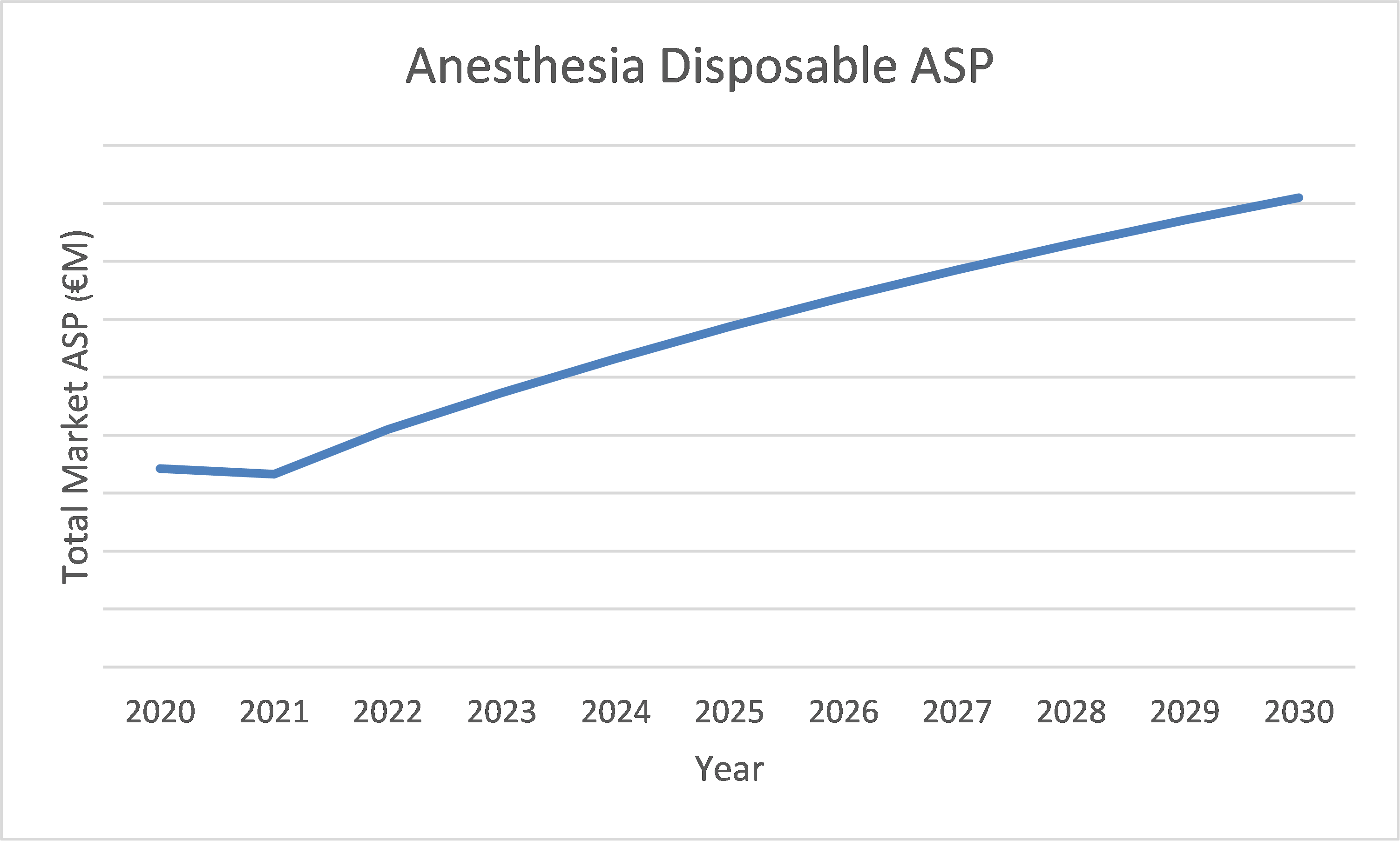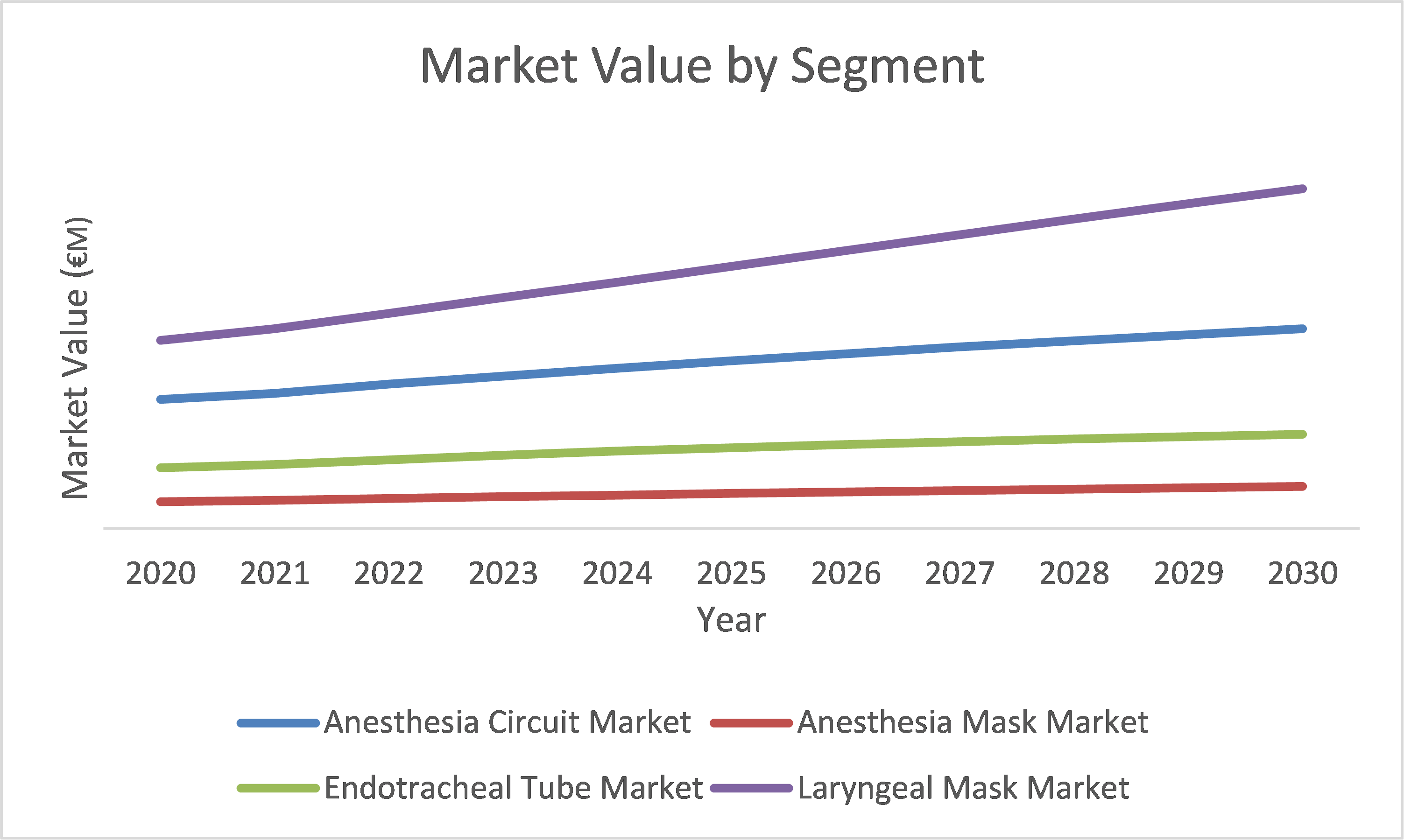 Anesthesia disposables are products used in conjunction with anesthesia delivery units (ADUs) and anesthesia monitors during the administration of general anesthesia. Anesthesia disposables can be classified into four categories; anesthesia circuits, anesthesia masks, endotracheal tubes and laryngeal masks.
Anesthesia disposables are products used in conjunction with anesthesia delivery units (ADUs) and anesthesia monitors during the administration of general anesthesia. Anesthesia disposables can be classified into four categories; anesthesia circuits, anesthesia masks, endotracheal tubes and laryngeal masks.
- Anesthesia circuits control the flow of gases from the anesthesia delivery unit to the patient and in the reverse direction. The circuits control the inflow of the mixture of air and anesthetic agents to the patient and the removal of gas waste (iData Research Inc., 2023).
- Anesthesia masks are used to deliver the anesthetic to the patient via inhalation and they typically cover both the nose and the mouth. For the safety of the medic, it is critical that the anesthetic gases are not leaking from the space between the mask and the patient’s face. In order to combat this issue, a smaller mask is typically contained within a larger outer mask, with a slight vacuum between the masks. Frequently, a bacterial filter is used between the anesthesia circuit and the mask or endotracheal tube to prevent the contamination of the ventilator and the escape of potentially contaminated air into the room (iData Research Inc., 2023).
- Endotracheal tubes (ETTs) are disposable devices which are inserted into the patient’s trachea, in order to deliver anesthetic into the lungs during surgery. They are the predominant method used to maintain a stable airway throughout many surgical procedures, as well as in emergency situations where positive pressure ventilation is required. Endotracheal tubes are used in situations such as when the respiratory tract requires protection from the aspiration of stomach contents, or in surgical procedures where the head or neck of the patient is in a non-supine position and in cases of neuromuscular paralysis (iData Research Inc., 2023).
- Laryngeal masks (LMs) are used in anesthesia and emergency medicine for airway management. LMs consist of a tube with an inflatable cuff that is inserted into the pharynx and generally present a smaller risk for pain, discomfort and complications than ETTs. LMs do not protect the lungs from aspiration, so they are contraindicated in cases where aspiration is a significant risk (iData Research Inc., 2023).
The European anesthesia disposables market is expected to see significant growth in the near future, not only because prices are increasing significantly, but also because there is a growing preference to use disposable products instead of reusable products in the majority of European countries.
Anesthesia Disposable Prices Increases
In recent years, average selling prices among all anesthesia disposable segments have increased by a notable margin. This is in large part due to high global inflation rates seen in 2022, which impacted the cost of producing these products. Additionally, the global supply chain was disrupted due to shipping delays, transportation constraints, increased energy costs and labor shortages, among other issues. However, because inflation and supply chain disruptions have impacted many different markets, even outside of the medical industry, consumers are more accepting of these price hikes. Therefore, any decrease in unit sales due to price increases is not proportional, causing growth in the market as a result.

Preference for Disposable Products
In recent years, it has been an overwhelming preference among clinicians to use single-use products over their reusable counterparts. This shift has taken place for a few reasons.
Perhaps the most significant reason for this shift is the risk of contamination among reusable products. Because these products would contain things like blood and bodily fluids after an operation, there is a cross-contamination risk even after thoroughly cleaning reusable products (BMP Medical, n.d.). This would not only be dangerous for the patient, but also poses as a liability risk for the hospital.
Another reason for the shift is the discussion of environmental impacts. Although the disposing of biomedical waste certainly has an environmental impact, the reprocessing of reusable products also has an impact. Reprocessing a reusable product requires a large amount of water, various chemicals and detergents, and electricity (BMP Medical, n.d.).
Similarly, the financial impact is also causing a shift to disposable products. By using reusable products, it is not only necessary to purchase appropriate cleaning supplies, but also increases labor costs, as the time to clean the reusable product is required, which is time that could have been saved by the use of a disposable product (McGain, Story, Lim, & McAlister, 2017).
Impact on the European Anesthesia Disposables Market
All four categories of the anesthesia disposables market are growing significantly. Of these, laryngeal masks (LMs) are growing the fastest. In addition to pricing increases and a preference for disposable products, additional growth is attributed to an increase in the use of LMs as an alternative to endotracheal tubes (ETTs), along with LMs being more affordable due to increased competition in the market. LMs also have several clinical advantages when compared to ETTs, such as ETTs requiring tilting of the head during use, which can prevent their use in cases where the head cannot be moved. ETTs also tend to slip into the major bronchi of the lungs, which leads to ventilation of only one lung. Finally, ETTs are inserted deep into the trachea, whereas LMs are only inserted so they sit tightly over the top of the larynx. The United Kingdom is especially prominent in the LM market and shifting away from ETTs since the U.K. are one of the biggest users of supraglottic airways. However, this is not to say ETTs are not growing in Europe, as they are also growing at a noticeable rate due to demographic factors such as an aging population and an increase in respiratory diseases.
Anesthesia circuits and masks are growing at a slower rate than LMs. Of the two, anesthesia masks are growing faster since they are more prevalent among the home care sector and also have more uses.

Conclusion
The overall anesthesia disposables market is growing at a fast rate. This is attributed to drivers positively impacting many medical markets, such as the aging population and the increasing prevalence in respiratory diseases. However, additional market drivers include price increases that are having a disproportionally lower effect on unit sales, as well as a preference for disposable products instead of reusable ones.
For further insights and more granular market data, please see the report Anesthesia, Respiratory & Sleep Therapy Devices Market Size, Share & Trends Analysis in Europe 2024-2030 by iData Research.
About the Authors
Graham Diett is a research analyst at iData Research. He develops and composes syndicated research projects regarding the medical device industry, publishing the U.S. Anesthesia, Respiratory and Sleep Management Device report series.
Kamran Zamanian, Ph.D., is CEO and founding partner of iData Research. He has spent over 20 years working in the market research industry with a dedication to the study of medical devices used in the health of patients all over the globe.
About iData Research
For 16 years, iData Research has been a strong advocate for data-driven decision-making within the global medical device, dental, and pharmaceutical industries. By providing custom research and consulting solutions, iData empowers its clients to trust the source of data and make important strategic decisions with confidence.
References
BMP Medical. (n.d.). Reasons to Switch to Single-USe Medical Devices and Disposable Medical Supplies.
iData Research Inc. (2023). EU Market Report Suite for Anesthesia, Respiratory, and Sleep Management Devices – 2023. Vancouver.
McGain, F., Story, D., Lim, T., & McAlister, S. (2017). Financial and Environmental Costs of Reusable and Single-Use Anaesthetic Equipment. British Journal of Anaesthesia, 862-869.








